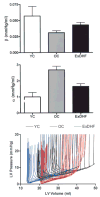Ventricular structure and function in aged dogs with renal hypertension: a model of experimental diastolic heart failure
- PMID: 15723971
- PMCID: PMC1805473
- DOI: 10.1161/01.CIR.0000157183.21404.63
Ventricular structure and function in aged dogs with renal hypertension: a model of experimental diastolic heart failure
Abstract
Background: Heart failure (HF) with normal ejection fraction (diastolic HF [DHF]) usually occurs in elderly patients with hypertension. The presence and significance of altered systolic and diastolic ventricular function in DHF is increasingly controversial. Our objective was to develop a clinically relevant large-animal model to better understand the pathophysiology of DHF.
Methods and results: Ventricular structure and function were characterized in young control (YC group; n=6), old control (OC group; n=7), and old dogs made hypertensive by renal wrapping (experimental DHF [ExDHF] group; n=8). The ExDHF group was associated with normal left ventricular (LV) volume, increased LV mass, and myocardial fibrosis. LV relaxation was impaired in ExDHF (tau=53+/-6 ms) compared with OC (tau=35+/-3 ms; P<0.05) and YC (tau=33+/-6 ms; P<0.05) dogs. The percent diastole at which relaxation is complete was increased in ExDHF (116+/-30%) compared with OC (69+/-8%; P<0.05) and YC (35+/-5%; P<0.05) dogs. The coefficient of LV diastolic stiffness was similar in OC, YC, and ExDHF dogs. Diastolic pressures increased dramatically in response to increases in blood pressure. End-systolic LV stiffness was enhanced in ExDHF dogs and after load enhancement of myocardial performance was maintained. Arterial stiffness was increased in ExDHF dogs.
Conclusions: Aged dogs with chronic hypertension exhibit LV hypertrophy and fibrosis with impaired LV relaxation but no increase in the coefficient of LV diastolic stiffness. LV systolic and arterial stiffness are increased, which may exacerbate load-dependent impairment of relaxation and contribute to increased filling pressures with hypertensive episodes. This model mimics many of the structural and functional characteristics described in the limited studies of human DHF and provides insight into the pathogenesis of DHF.
Figures








Similar articles
-
Left ventricular systolic performance, function, and contractility in patients with diastolic heart failure.Circulation. 2005 May 10;111(18):2306-12. doi: 10.1161/01.CIR.0000164273.57823.26. Epub 2005 Apr 25. Circulation. 2005. PMID: 15851588
-
Beta-blocker improves survival, left ventricular function, and myocardial remodeling in hypertensive rats with diastolic heart failure.Am J Hypertens. 2004 Dec;17(12 Pt 1):1112-9. doi: 10.1016/j.amjhyper.2004.07.007. Am J Hypertens. 2004. PMID: 15607617
-
Mineralocorticoid signaling in transition to heart failure with normal ejection fraction.Hypertension. 2008 Feb;51(2):289-95. doi: 10.1161/HYPERTENSIONAHA.107.099010. Epub 2007 Dec 17. Hypertension. 2008. PMID: 18086943
-
Systolic and diastolic dyssynchrony in patients with diastolic heart failure and the effect of medical therapy.J Am Coll Cardiol. 2007 Jan 2;49(1):88-96. doi: 10.1016/j.jacc.2006.10.023. Epub 2006 Nov 1. J Am Coll Cardiol. 2007. PMID: 17207727 Review.
-
Congestive heart failure due to hypertensive ventricular diastolic dysfunction.Am J Cardiol. 1995 Nov 2;76(13):43D-47D. doi: 10.1016/s0002-9149(99)80491-3. Am J Cardiol. 1995. PMID: 7495217 Review.
Cited by
-
Large Animal Models of Heart Failure: A Translational Bridge to Clinical Success.JACC Basic Transl Sci. 2020 Aug 24;5(8):840-856. doi: 10.1016/j.jacbts.2020.04.011. eCollection 2020 Aug. JACC Basic Transl Sci. 2020. PMID: 32875172 Free PMC article. Review.
-
Sexual dimorphism in animal models of heart failure with preserved ejection fraction.J Appl Physiol (1985). 2025 Jun 1;138(6):1449-1473. doi: 10.1152/japplphysiol.00595.2024. Epub 2025 May 5. J Appl Physiol (1985). 2025. PMID: 40323734 Free PMC article. Review.
-
Enhanced resistance to permeability transition in interfibrillar cardiac mitochondria in dogs: effects of aging and long-term aldosterone infusion.Am J Physiol Heart Circ Physiol. 2013 Feb 15;304(4):H514-28. doi: 10.1152/ajpheart.00674.2012. Epub 2012 Dec 15. Am J Physiol Heart Circ Physiol. 2013. PMID: 23241318 Free PMC article.
-
Clinical Phenotypes of Heart Failure With Preserved Ejection Fraction to Select Preclinical Animal Models.JACC Basic Transl Sci. 2022 May 25;7(8):844-857. doi: 10.1016/j.jacbts.2021.12.009. eCollection 2022 Aug. JACC Basic Transl Sci. 2022. PMID: 36061340 Free PMC article. Review.
-
Comparison of the effect of pressure loading on left ventricular size, systolic and diastolic function in canines with left ventricular dysfunction with preserved and reduced ejection fraction.Cardiovasc Ultrasound. 2008 Nov 18;6:57. doi: 10.1186/1476-7120-6-57. Cardiovasc Ultrasound. 2008. PMID: 19014711 Free PMC article.
References
-
- Hart CY, Redfield MM. Diastolic heart failure in the community. Current Cardiol Reports. 2000;2:461–469. - PubMed
-
- Zile MR, Brutsaert DL. New concepts in diastolic dysfunction and diastolic heart failure, part II: causal mechanisms and treatment. Circulation. 2002;105:1503–1508. - PubMed
-
- Zile MR, Gaasch WH, Carroll JD, Feldman MD, Aurigemma GP, Schaer GL, Ghali JK, Liebson PR. Heart failure with normal ejection fraction: is measurement of diastolic function necessary to make the diagnosis of diastolic heart failure? Circulation. 2001;104:779–782. - PubMed
-
- Zile MR, Baicu CF, Gaasch WH. Diastolic heart failure: abnormalities in active relaxation and passive stiffness of the left ventricle. N Engl J Med. 2004;350:1953–1959. - PubMed
-
- Kawaguchi M, Hay I, Fetics B, Kass DA. Combined ventricular systolic and arterial stiffening in patients with heart failure and preserved ejection fraction. Circulation. 2003;107:714–720. - PubMed
Publication types
MeSH terms
Grants and funding
LinkOut - more resources
Full Text Sources
Medical
Research Materials
Miscellaneous

